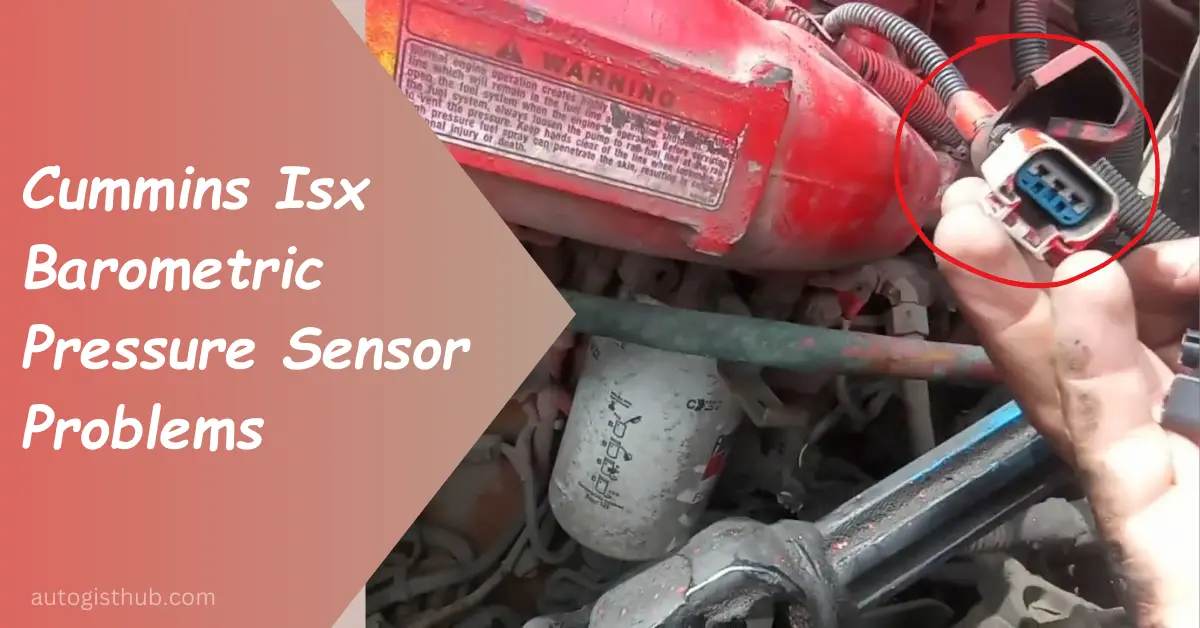Cummins ISX barometric pressure sensor problems can cause issues with engine performance and fuel efficiency. In this blog post, we will explore common symptoms of sensor problems and provide solutions to resolve them effectively.
The barometric pressure sensor is a crucial component in the Cummins ISX engine, as it helps regulate fuel injection and air-to-fuel ratio. When this sensor malfunctions, it can lead to imprecise calculations, resulting in poor engine performance. Some common signs of sensor problems include engine misfires, rough idling, decreased power, and increased fuel consumption.
To address these issues, proper diagnosis and troubleshooting are necessary. This may involve checking the sensor’s wiring connections, testing its voltage output, or simply replacing a faulty sensor. By understanding the symptoms and solutions related to Cummins ISX barometric pressure sensor problems, you can effectively maintain your engine’s performance and efficiency.
When to Seek Professional Help
When dealing with Cummins ISX barometric pressure sensor problems, it’s important to know when it’s time to seek professional help. While some issues can be resolved by DIY enthusiasts, there are certain indications that professional intervention is necessary.
Lgnoring these signs could lead to further complications and potential damage to your vehicle. In this section, we will highlight the indications that signal the need for expert assistance, as well as the benefits of letting professionals handle sensor repairs.
Indications That Professional Intervention Is Necessary
When it comes to Cummins ISX barometric pressure sensor problems, there are telltale signs that should not be overlooked. Such indications include:
- Error codes: If your vehicle’s onboard diagnostic system displays error codes related to the barometric pressure sensor, it’s a strong sign that professional help is required. These error codes are specific to sensor malfunctions, and attempting to diagnose and repair them without the necessary expertise can be risky.
- Unusual engine behavior: If you notice erratic engine performance such as frequent stalling, sudden loss of power, or difficulty starting the engine, it may be due to a faulty barometric pressure sensor. Professional technicians have the experience and knowledge to accurately diagnose the problem and provide the necessary repairs.
- Inaccurate readings: A malfunctioning barometric pressure sensor can result in inconsistent readings on your vehicle’s gauge. If you notice significant variations in the readings or if the gauge remains stuck at a certain level, it’s crucial to seek professional assistance to avoid potential engine damage or poor fuel economy.
- Other associated symptoms: In addition to the aforementioned indications, other symptoms like excessive fuel consumption, rough idle, or the illumination of the Check Engine Light may also point to barometric pressure sensor issues. These symptoms should not be ignored, as they can have long-lasting effects on your vehicle’s performance.
Benefits of Letting Experts Handle Sensor Repairs
Choosing to have professionals handle Cummins ISX barometric pressure sensor repairs offers several advantages:
- Experience and expertise: Certified technicians have comprehensive knowledge of Cummins engines and their components. They are familiar with the complexities of barometric pressure sensors and can accurately diagnose and repair the issues.
- Quality repairs: Professional technicians use specialized tools, equipment, and genuine Cummins parts to ensure high-quality repairs. This helps in restoring the optimal performance of your vehicle and minimizing the chances of future problems.
- Time and cost savings: While DIY repairs may seem cost-effective initially, incorrect repairs can lead to further damage and additional expenses. By seeking professional help, you avoid potential mistakes and wastage of time and money on trial-and-error solutions.
- Warranty protection: Opting for professional repairs ensures that your vehicle’s warranty remains intact. Manufacturers often require repairs to be performed by authorized technicians to maintain warranty coverage.
By recognizing the indications that professional intervention is necessary and understanding the benefits of expert sensor repairs, you can make an informed decision regarding the best course of action for resolving Cummins ISX barometric pressure sensor problems.
Symptoms of a Faulty Barometric Pressure Sensor
A barometric pressure sensor plays a crucial role in ensuring the efficient functioning of your Cummins ISX engine. However, just like any other component, this sensor is prone to developing problems over time. If you suspect that your barometric pressure sensor is faulty, it’s essential to be aware of the symptoms so that you can take prompt action.
Common Signs of a Defective Sensor
Identifying the signs of a faulty barometric pressure sensor is crucial in diagnosing any potential issues with your Cummins ISX engine. Here are some common indications that might suggest your sensor is malfunctioning:
- Unexpected engine stalling: A defective barometric pressure sensor can cause your engine to stall unexpectedly while idling or when driving at low speeds. This occurs due to inaccurate pressure readings, leading to incorrect fuel-to-air ratios.
- Poor fuel efficiency: If you notice a sudden decrease in fuel efficiency, it could be attributed to a faulty barometric pressure sensor. The sensor helps regulate the fuel injection process by providing input to the engine control unit (ECU). When the sensor malfunctions, it can result in an imbalanced air-fuel mixture, leading to increased fuel consumption.
- Inconsistent engine performance: A malfunctioning sensor can result in irregular engine performance. You may experience rough idling or notice a loss of power, hesitation, or surging while accelerating. These symptoms occur because the ECU is receiving inaccurate data from the sensor, causing it to make incorrect adjustments to the engine’s timing and fuel delivery.
- Illuminated warning lights: A defective barometric pressure sensor can trigger the check engine light on your dashboard. It is crucial to pay attention to these warning lights as they serve as an early indication of potential engine problems.
Impact of Sensor Malfunction on Engine Performance
When a barometric pressure sensor malfunctions, it can significantly affect the overall performance of your Cummins ISX engine. Here are some specific ways in which a faulty sensor can impact engine performance:
- Inaccurate air-fuel ratio: The barometric pressure sensor assists in determining the optimal air-fuel ratio for combustion. When it malfunctions, the engine control unit cannot accurately calculate the amount of air entering the engine, resulting in an incorrect fuel mixture. This can lead to decreased power, increased emissions, and reduced fuel efficiency.
- Reduced engine power: A malfunctioning sensor can cause the engine to experience a decrease in power. Inefficient fuel combustion due to inaccurate pressure readings can result in reduced horsepower and torque output, compromising the engine’s overall performance.
- Emission control issues: A faulty barometric pressure sensor can negatively impact the engine’s emission control system. Inaccurate pressure readings can lead to improper fuel combustion, resulting in increased emissions of harmful pollutants. This not only affects the environment but can also cause your vehicle to fail emissions tests.
Being aware of the symptoms of a faulty barometric pressure sensor is essential in maintaining the optimal performance of your Cummins ISX engine. If you notice any of these signs, it’s crucial to have the sensor diagnosed and replaced by a qualified technician to prevent further damage and ensure your engine operates at peak efficiency.
Repairing a Cummins Isx Barometric Pressure Sensor
Repairing a Cummins ISX Barometric Pressure Sensor The barometric pressure sensor plays a crucial role in the proper functioning of the Cummins ISX engine. It measures the air pressure in the environment, which is essential for determining the optimal air-fuel ratio for combustion.
However, like any other component, the barometric pressure sensor in a Cummins ISX can experience problems over time. Diagnosing sensor problems To ensure the smooth operation of your Cummins ISX engine, it is important to be able to identify and diagnose any issues with the barometric pressure sensor. Here are the steps you can follow to determine if your sensor is causing performance problems:
Steps to Diagnose Sensor Problems
- Start by checking for any error codes or fault messages in the engine control module (ECM). These codes can provide you with valuable information regarding the sensor’s malfunction.
- Inspect the sensor and its wiring for any visible signs of damage, such as frayed wires or corrosion. Ensuring the sensor is properly connected and the wiring is intact is crucial.
- Use a multimeter to test the voltage output of the barometric pressure sensor. Compare the reading to the specifications provided by the manufacturer to determine if the sensor is functioning within the expected range.
- If the voltage reading is outside the acceptable range, consider replacing the sensor to ensure accurate readings and optimal engine performance.
- Additionally, check the intake manifold for any air leaks that could affect the barometric pressure sensor’s readings. These leaks can lead to false measurements and impact the engine’s efficiency.
Possible DIY solutions for minor issues Not all barometric pressure sensor problems require professional intervention. In some cases, minor issues can be easily resolved with simple do-it-yourself solutions. Here are a few steps you can take to address common sensor problems:
Possible Diy Solutions for Minor Issues
- First, clean the sensor using electrical contact cleaner and a soft cloth. This can remove any dirt or debris that might be affecting its performance.
- Ensure that the sensor is properly aligned and securely mounted in its designated location. Loose or misaligned sensors can lead to inaccurate readings and subsequent engine issues.
- Check the sensor’s wiring for any loose connections or damaged wires. Tighten any loose connections and replace any damaged wires if necessary.
- If the sensor is giving erratic readings, consider resetting the ECM by disconnecting the battery for a few minutes. This can sometimes resolve minor communication errors between the sensor and the ECM.
- Finally, it is always a good idea to consult the Cummins ISX engine’s service manual for specific troubleshooting steps and guidance.
By following these diagnostic steps and possible DIY solutions, you can effectively address barometric pressure sensor problems in your Cummins ISX engine. Regular maintenance and timely repairs will help ensure the sensor operates optimally, leading to improved engine performance and efficiency.
Remember, if you encounter significant issues or are unsure about the repair process, it is advisable to seek professional assistance to avoid any potential damage to your engine.
What is the Cummins Isx Barometric Pressure Sensor?
The Cummins ISX Barometric Pressure Sensor is a crucial component in the engine management system of Cummins ISX engines. It is responsible for measuring the atmospheric pressure and providing accurate information to the engine control unit (ECU), allowing it to make necessary adjustments to optimize engine performance.
Importance of the Sensor in Engine Performance
The barometric pressure sensor is of utmost importance in ensuring the proper functioning of Cummins ISX engines. It helps the engine control unit accurately adjust the air-fuel ratio, ignition timing, and turbocharger boost, based on the prevailing atmospheric pressure. By continuously monitoring the barometric pressure, the sensor ensures that the engine operates optimally, regardless of changes in altitude or weather conditions.
This sensor also plays a crucial role in achieving compliance with emission standards. By providing accurate data regarding the atmospheric pressure, the barometric pressure sensor enables the engine control unit to adjust the fuel injection timing and quantity, leading to more efficient combustion and a reduction in harmful emissions.
The barometric pressure sensor’s ability to continuously monitor and provide real-time data is critical for engine performance and longevity. It ensures that the engine operates within its specified parameters, preventing potential damage or failure caused by inadequate air-fuel mixture or excessive turbocharger boost. Additionally, by optimizing engine performance, this sensor contributes to increased fuel efficiency, reduced maintenance costs, and improved overall vehicle performance.
Troubleshooting Cummins Isx Barometric Pressure Sensor Problems
The Cummins ISX engine is a powerful and reliable engine commonly used in heavy-duty trucks. However, like any other engine component, the barometric pressure sensor can sometimes encounter issues that affect the engine’s performance. Identifying and resolving these problems promptly is crucial to maintain the optimal functioning of the engine.
Common Issues and Their Potential Causes
Understanding the common issues associated with the barometric pressure sensor in the Cummins ISX engine can help you troubleshoot and address them effectively. Here are some frequent problems and their potential causes:
- Incorrect readings: If your barometric pressure sensor is providing inaccurate readings, it could be due to a faulty sensor or a damaged connector. Additionally, exposure to oil or debris can also lead to faulty readings.
- Inconsistent performance: If you are experiencing inconsistent engine performance, it may be caused by a loose or corroded connection. A loose connection can disrupt the communication between the sensor and the engine control module, resulting in irregular engine behavior.
- Engine hesitation: Engine hesitation or stalling can occur when the barometric pressure sensor fails to provide the proper information to the engine control module. This can be caused by a faulty sensor, worn-out wiring, or a damaged connector.
- Warning lights: If the check engine light or other warning lights are illuminated on your dashboard, it could indicate a problem with the barometric pressure sensor. This can be due to a faulty sensor, wiring issues, or a malfunctioning engine control module.
- Poor fuel efficiency: A malfunctioning barometric pressure sensor can affect fuel regulation, leading to poor fuel efficiency. Issues such as a clogged sensor or a damaged connector can disrupt the fuel-air mixture, resulting in decreased mileage.
Resolving barometric pressure sensor problems in the Cummins ISX engine requires a systematic approach. By following these steps, you can identify and address the sensor-related issues:
- Inspect the sensor: Begin by visually inspecting the barometric pressure sensor for any signs of damage or debris. Ensure that the sensor is securely connected and that the wiring is intact.
- Check the connectors: Examine the connectors attached to the sensor for any corrosion or loose connections. Clean the connectors if necessary and tighten any loose connections.
- Perform a diagnostic scan: Connect a diagnostic tool to the Cummins ISX engine to retrieve any error codes related to the sensor. This will provide valuable information about the specific problem.
- Replace the sensor if necessary: If the diagnostic scan confirms a faulty barometric pressure sensor, it is advisable to replace it with a new, high-quality sensor recommended by Cummins or an authorized dealer.
- Test the new sensor: After replacing the sensor, conduct a test to ensure that it is functioning correctly. Monitor the engine performance and check for any improvement in engine operation and fuel efficiency.
By following this step-by-step guide, you can identify and resolve barometric pressure sensor problems in your Cummins ISX engine effectively. Remember to consult the engine’s manual or seek professional assistance if you encounter any difficulties during the troubleshooting process.
Preventing Future Cummins Isx Barometric Pressure Sensor Problems
Ensuring the smooth performance of your Cummins ISX engine is crucial to maximizing its lifespan and minimizing costly repairs. One component that often encounters issues is the barometric pressure sensor.
This sensor plays a vital role in accurately measuring the air density and enabling the engine control module (ECM) to make necessary adjustments for optimum performance. To prevent future Cummins ISX barometric pressure sensor problems and avoid disruptions to your truck’s operation, here are some effective strategies and tips to follow:
Strategies for Avoiding Sensor Issues Altogether
While occasional sensor malfunctions may be unavoidable, following these strategies can significantly reduce the likelihood of encountering barometric pressure sensor problems:
Regular Engine Inspection and Maintenance
- Ensure that your truck undergoes regular engine inspections and maintenance schedules. This includes checking and cleaning the barometric pressure sensor and its associated components.
- Monitor the sensor’s readings regularly using diagnostic tools to identify any abnormal patterns or deviations.
Proper Installation and Wiring
- During sensor replacements, make sure to carefully install the new sensor according to the manufacturer’s guidelines.
- Double-check the wiring connections to eliminate the risk of loose or damaged wires.
Tips for Extending the Lifespan of the Sensor
Even with proactive measures in place, it’s essential to implement additional steps to prolong the lifespan of the barometric pressure sensor. By following these tips, you can minimize the potential for sensor failure:
Regular Cleaning
Periodically clean the sensor to remove any dirt, debris, or oil buildup that could affect its performance. Use a gentle, non-abrasive cleaning agent and avoid applying excessive force to prevent damage to the sensor.
Temperature and Moisture Control
Maintain proper temperature and moisture levels within the engine compartment. Extreme temperatures and excessive moisture can lead to sensor malfunction. Ensure adequate insulation and ventilation, especially in harsh weather conditions.
Quality Fuel and Air Filters
Regularly replace fuel and air filters according to the manufacturer’s recommendations. Clean filters prevent contaminants from entering the engine, reducing the likelihood of sensor damage.
By implementing these strategies and tips, you can greatly reduce the risk of Cummins ISX barometric pressure sensor problems. Remember, regular maintenance and proper installation go a long way in ensuring the smooth operation of your truck’s engine. Taking proactive measures will not only extend the lifespan of the sensor but also minimize the need for costly repairs and downtime.
Maintaining the Barometric Pressure Sensor for Optimal Performance
The barometric pressure sensor is a crucial component of the Cummins ISX engine, responsible for measuring the atmospheric pressure and relaying this information to the engine control module. This data is vital for the engine to adjust its performance and ensure optimal fuel efficiency, power, and emissions control.
To keep your Cummins ISX engine running smoothly, it is essential to regularly maintain the barometric pressure sensor. In this section, we will explore the importance of regular sensor maintenance and provide you with valuable tips to keep the sensor in good condition.
Importance of Regular Sensor Maintenance
Regular maintenance is key to maximizing the lifespan and performance of any engine component, and the barometric pressure sensor is no exception. By keeping the sensor in optimal condition, you can reap the following benefits:
- Accurate Performance: A well-maintained barometric pressure sensor ensures that the engine receives precise atmospheric pressure readings, allowing it to adjust its operations accordingly. This accuracy translates into improved fuel efficiency, reduced emissions, and enhanced overall performance.
- Reliable Emissions Control: The barometric pressure sensor plays a critical role in emissions control systems. By regularly maintaining this sensor, you can ensure its seamless integration with other engine components, enabling proper regulation of emissions and compliance with environmental regulations.
- Prevent Costly Repairs: Neglecting the maintenance of the barometric pressure sensor can lead to a variety of issues, including inaccurate sensor readings and faulty engine performance. These issues can escalate over time, potentially causing severe damage to other engine components. By investing in regular maintenance, you can prevent costly repairs and preserve the longevity of your Cummins ISX engine.
Tips for Keeping the Sensor in Good Condition
Now that we understand the importance of maintaining the barometric pressure sensor, let’s dive into some valuable tips to help you keep this essential component in good condition:
- Regular Inspections: Inspect the sensor for any signs of physical damage, such as cracks or corrosion. Ensure that all connections are secure and properly sealed. Regular inspections can help detect any potential issues early on, allowing for prompt repairs or replacements.
- Cleanliness: Keep the sensor clean and free from dirt, dust, and debris. These contaminants can interfere with the sensor’s accuracy and cause malfunction. Use a mild solvent and a soft cloth to gently clean the sensor when necessary. Avoid using abrasive materials that could damage its delicate components.
- Follow Manufacturer’s Recommendations: Adhere to the maintenance guidelines provided by the Cummins ISX engine manufacturer. These guidelines often include recommendations for sensor inspection, cleaning, and replacement intervals. By following these recommendations, you can ensure that your sensor remains in peak condition.
- Professional Servicing: If you lack the technical expertise or time to perform maintenance tasks yourself, consider seeking professional servicing for your Cummins ISX engine. Trained technicians can conduct thorough inspections and maintenance routines, ensuring the sensor and other engine components are properly taken care of.
- Use Quality Replacement Parts: When it comes to sensor replacements, always opt for genuine and high-quality parts recommended by the manufacturer. Inferior or counterfeit parts may compromise the sensor’s accuracy and performance, leading to further issues down the line. Invest in reliability and longevity by using quality replacements.
By implementing these tips, you can maintain the barometric pressure sensor of your Cummins ISX engine for optimal performance. Remember, a well-maintained sensor contributes to fuel efficiency, emissions control, and overall engine longevity. Take the necessary steps today to ensure your engine runs smoothly and efficiently.
FAQs For Cummins Isx Barometric Pressure Sensor Problems
Symptoms of a bad barometric pressure sensor include rough engine idle, poor fuel efficiency, and irregular engine performance. Other signs can include trouble starting the engine, engine misfires, and illuminated warning lights on the dashboard.
A barometric pressure sensor measures atmospheric pressure and helps determine changes in weather conditions accurately.
A faulty baro sensor can trigger an engine code.
Conclusion
To sum up, addressing Cummins ISX barometric pressure sensor problems is crucial for maintaining the engine’s performance and efficiency. By understanding the symptoms and potential causes, as well as implementing appropriate diagnostic and repair procedures, you can prevent further issues and ensure the smooth operation of your Cummins ISX engine.
Remember to consult with a qualified technician for accurate diagnosis and effective solutions.




